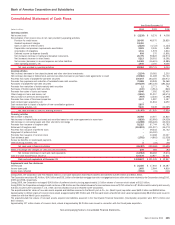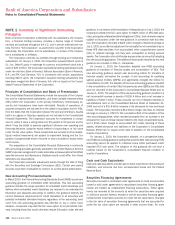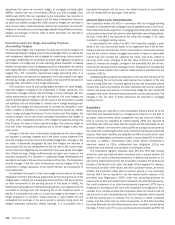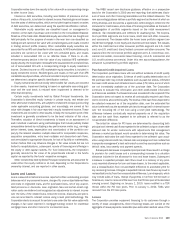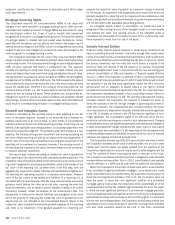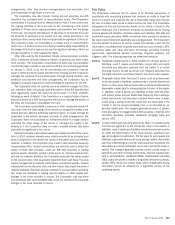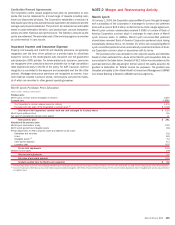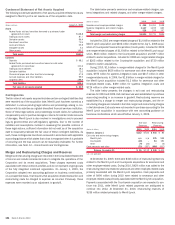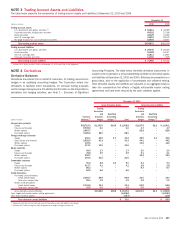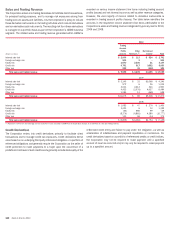Bank of America 2010 Annual Report Download - page 154
Download and view the complete annual report
Please find page 154 of the 2010 Bank of America annual report below. You can navigate through the pages in the report by either clicking on the pages listed below, or by using the keyword search tool below to find specific information within the annual report.equipment, and the shorter of lease term or estimated useful life for lease-
hold improvements.
Mortgage Servicing Rights
The Corporation accounts for consumer-related MSRs at fair value with
changes in fair value recorded in mortgage banking income, while commer-
cial-related and residential reverse mortgage MSRs are accounted for using
the amortization method (i.e., lower of cost or market) with impairment
recognized as a reduction in mortgage banking income. To reduce the volatility
of earnings related to interest rate and market value fluctuations, certain
securities and derivatives such as options and interest rate swaps may be
used as economic hedges of the MSRs, but are not designated as accounting
hedges. These economic hedges are carried at fair value with changes in fair
value recognized in mortgage banking income.
The Corporation estimates the fair value of the consumer-related MSRs
using a valuation model that calculates the present value of estimated future
net servicing income. This is accomplished through an option-adjusted spread
(OAS) valuation approach that factors in prepayment risk. This approach
consists of projecting servicing cash flows under multiple interest rate sce-
narios and discounting these cash flows using risk-adjusted discount rates.
The key economic assumptions used in valuations of MSRs include weighted-
average lives of the MSRs and the OAS levels. The OAS represents the spread
that is added to the discount rate so that the sum of the discounted cash flows
equals the market price, therefore it is a measure of the extra yield over the
reference discount factor (i.e., the forward swap curve) that the Corporation
expects to earn by holding the asset. These variables can, and generally do,
change from quarter to quarter as market conditions and projected interest
rates change, and could have an adverse impact on the value of the MSRs and
could result in a corresponding reduction in mortgage banking income.
Goodwill and Intangible Assets
Goodwill is calculated as the purchase premium after adjusting for the fair
value of net assets acquired. Goodwill is not amortized but is reviewed for
potential impairment on an annual basis, or when events or circumstances
indicate a potential impairment, at the reporting unit level. A reporting unit, as
defined under applicable accounting guidance, is a business segment or one
level below a business segment. The goodwill impairment analysis is a two-
step test. The first step of the goodwill impairment test involves comparing the
fair value of each reporting unit with its carrying amount including goodwill. If
the fair value of the reporting unit exceeds its carrying amount, goodwill of the
reporting unit is considered not impaired; however, if the carrying amount of
the reporting unit exceeds its fair value, the second step must be performed
to measure potential impairment.
The second step involves calculating an implied fair value of goodwill for
each reporting unit for which the first step indicated possible impairment. The
implied fair value of goodwill is determined in the same manner as the amount
of goodwill recognized in a business combination, which is the excess of the
fair value of the reporting unit, as determined in the first step, over the
aggregate fair values of the assets, liabilities and identifiable intangibles as if
the reporting unit was being acquired in a business combination. Measure-
ment of the fair values of the assets and liabilities of a reporting unit is
consistent with the requirements of the fair value measurements accounting
guidance, which defines fair value as an exit price, meaning the price that
would be received to sell an asset or paid to transfer a liability in an orderly
transaction between market participants at the measurement date. The
adjustments to measure the assets, liabilities and intangibles at fair value
are for the purpose of measuring the implied fair value of goodwill and such
adjustments are not reflected in the Consolidated Balance Sheet. If the
implied fair value of goodwill exceeds the goodwill assigned to the reporting
unit, there is no impairment. If the goodwill assigned to a reporting unit
exceeds the implied fair value of goodwill, an impairment charge is recorded
for the excess. An impairment loss recognized cannot exceed the amount of
goodwill assigned to a reporting unit. An impairment loss establishes a new
basis in the goodwill and subsequent reversals of goodwill impairment losses
are not permitted under applicable accounting guidance.
For intangible assets subject to amortization, an impairment loss is
recognized if the carrying amount of the intangible asset is not recoverable
and exceeds fair value. The carrying amount of the intangible asset is
considered not recoverable if it exceeds the sum of the undiscounted cash
flows expected to result from the use of the asset.
Variable Interest Entities
A VIE is an entity that lacks equity investors or whose equity investors do not
have a controlling financial interest in the entity through their equity invest-
ments. The entity that has a controlling financial interest in a VIE is referred to
as the primary beneficiary and consolidates the VIE. Prior to January 1, 2010,
the primary beneficiary was the entity that would absorb a majority of the
economic risks and rewards of the VIE based on an analysis of projected
probability-weighted cash flows. In accordance with the new accounting guid-
ance on consolidation of VIEs and transfers of financial assets effective
January 1, 2010, the Corporation is deemed to have a controlling financial
interest and is the primary beneficiary of a VIE if it has both the power to direct
the activities of the VIE that most significantly impact the VIE’s economic
performance and an obligation to absorb losses or the right to receive
benefits that could potentially be significant to the VIE. On a quarterly basis,
the Corporation reassesses whether it has a controlling financial interest in
and is the primary beneficiary of a VIE. The quarterly reassessment process
considers whether the Corporation has acquired or divested the power to
direct the activities of the VIE through changes in governing documents or
other circumstances. The reassessment also considers whether the Corpo-
ration has acquired or disposed of a financial interest that could be significant
to the VIE, or whether an interest in the VIE has become significant or is no
longer significant. The consolidation status of the VIEs with which the Cor-
poration is involved may change as a result of such reassessments. Changes
in consolidation status are applied prospectively, with assets and liabilities of
a newly consolidated VIE initially recorded at fair value. A gain or loss may be
recognized upon deconsolidation of a VIE depending on the carrying amounts
of deconsolidated assets and liabilities compared to the fair value of retained
interests and ongoing contractual arrangements.
The Corporation primarily uses VIEs for its securitization activities, in which
the Corporation transfers whole loans or debt securities into a trust or other
vehicle such that the assets are legally isolated from the creditors of the
Corporation. Assets held in a trust can only be used to settle obligations of the
trust. The creditors of these trusts typically have no recourse to the Corpo-
ration except in accordance with the Corporation’s obligations under standard
representations and warranties. Prior to 2010, securitization trusts typically
met the definition of a QSPE and as such were not subject to consolidation.
When the Corporation is the servicer of whole loans held in a securitization
trust, including non-agency residential mortgages, home equity loans, credit
cards, automobile loans and student loans, the Corporation has the power to
direct the most significant activities of the trust. The Corporation does not
have the power to direct the most significant activities of a residential
mortgage agency trust unless the Corporation holds substantially all of the
issued securities and has the unilateral right to liquidate the trust. The power
to direct the most significant activities of a commercial mortgage securitiza-
tion trust is typically held by the special servicer or by the party holding specific
subordinate securities which embody certain controlling rights. In accordance
with the new accounting guidance, the Corporation consolidates a whole loan
securitization trust if it has the power to direct the most significant activities
and also holds securities issued by the trust or has other contractual
152 Bank of America 2010





